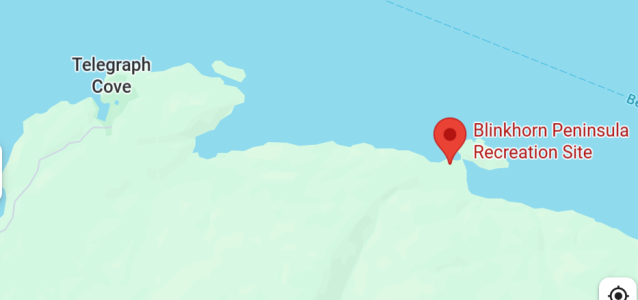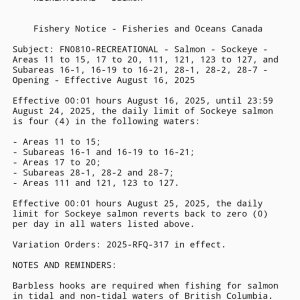Story in today's Times Colonist -
https://www.timescolonist.com/local...ed-in-test-catch-in-johnstone-strait-11041602
Record number of early sockeye recorded in test catch in Johnstone Strait
On July 31, 14,550 sockeye were caught on the Johnstone Strait test fishery boat — the highest July daily catch recorded since test fishing began.
Na̱mǥis fishers on the water on Aug. 1 doing a test fishery catch for the Department on Fisheries and Oceans, where about 10,000 fish were caught, 4,500 of them sockeye. After some sample fish were taken, the catch was returned to the sea. VIA DON SVANVIK
Early numbers are promising for sockeye salmon headed to the Fraser River through the Johnstone Strait.
Alexandra Morton, an independent Island-based biologist who has been keeping a close watch on the salmon run numbers, said that on July 31, 14,550 sockeye were caught on the Johnstone Strait test fishery boat — the highest July daily catch recorded since test fishing began.
Morton said her phone has been blowing up with texts from people overjoyed by the news, as well as the run of early Stuart sockeye, which goes up to Takla Lake in northern B.C.
That run is already in the Fraser River and is currently being counted by the Department of Fisheries and Oceans.
DFO has already reached a count of 700,000, above the 160,000 initial estimate that the federal agency gave this year, she said.
DFO spokesperson Leri Davies said the agency is unable to attribute increased salmon returns to any single factor at this point, but the large return could not have happened without the combined efforts of First Nations and the provincial and federal governments.
The rebound for early Stuart sockeye comes six years after a major landslide in the Fraser River blocked salmon from reaching their spawning grounds, she said in a statement.
Commercial and recreational fisheries opportunities may come as more information about the salmon run is collected, she said, adding that First Nation fisheries remain the priority while conservation measures are in place.
On Aug. 1, ʼNa̱mǥis fishers were among those who headed out to catch salmon for food, social and ceremonial purposes over a four-day fishery window.
Another fishing window for First Nations opened midnight on Wednesday and will close Aug. 9.
Na̱mǥis hereditary chief and retired fisher Don Svanvik said ʼNa̱mǥis is allocated a quota of 5,000 sockeye, which means members will likely get around a dozen salmon each if they are able to catch the quota.
ʼNa̱mǥis have only been allowed to fish in four of the past 15 years of sockeye salmon runs — in 2010, 2014, 2018 and 2022 — due to a severe drop in returning numbers, Svanvik said.
It’s gotten to the point where some people think the sockeye only return to the rivers every four years, he said.
But this year is shaping up to be a good run, he said.
Before the turn of the century, when sockeye was more plentiful, his family would catch 100 to 150 sockeye a year, said Svanvik, adding the fish are nicknamed “sliders” after the species’ tendency to make half-circle jumps out of the water.
Right now, everybody on Johnstone Strait is seeing those fins flash across the water, he said.
Svanvik and Morton both attribute the rebound of the sockeye run this year, at least in part, to the 2021 closure of Atlantic salmon fish farms off the east coast of Vancouver Island.
“This year and last year [are] the first runs where we’re starting to see fish come back that were not exposed to salmon farms when they were juveniles,” said Morton, who has opposed fish farms on the west coast for decades. “People are wondering, is this part of why the numbers are so huge? Because they’re not huge in the Columbia, the Barkley, the Skeena, the other big sockeye rivers.”
The salmon returning to the rivers to spawn would have gone out to the Pacific as smolts in 2023, she said.
David Knox, Kwakiutl hereditary chief and elected councillor for Kwakiutl First Nation, said there are too many factors to point to a single one causing the rebound for salmon runs going through the Johnstone Strait.
Since fish farms began operating in the area 35 years ago, there has been a massive sockeye run in 2015, a major chum salmon run in 2021, and sizeable returns of pink salmon, too, he said.
Logging and mining in areas where salmon spawn, as well as ocean-floor trawlers, are other major threats to salmon that aren’t talked about as much, Knox said. “I worked on those boats for five years, so that’s why I can talk about the impacts — because I witnessed it.”
Knox said there’s grumbling among Indigenous people who want to fish the sockeye run for economic gain.
“They’re suppressing us from being able to gather our resources,” said Knox, who is planning to start a “pre-confederation” fishery outside the DFO process that he says his nation has the right to under the 1851 Fort Rupert Douglas treaties.
The Pacific Salmon Commission said commercial salmon fishing in Fraser River-area waters remains closed in both Canada and the U.S.
The latest commission report estimates that about six in 10 sockeye are shifting their migration route from the Strait of Juan de Fuca to Johnstone Strait.
Morton said there still is a lot that needs to change before salmon runs aren’t threatened anymore, but this year’s early results show the salmon remain resilient.
“To see these fish turn on like this is just so hopeful. One day we will be able to have abundant salmon running through these waters again.”
mjlo@timescolonist.com


